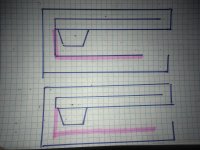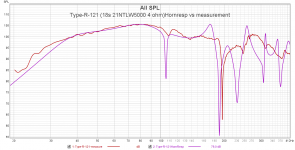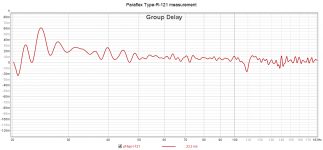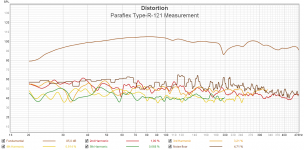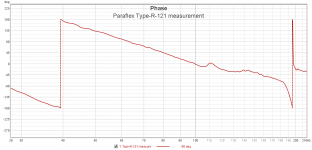when you get one together and start listening to it, it will not be ‘perfect’ and nothing will be more obvious until a couple weeks and the ‘new’ wheres off. All thats left is a unique punchy and pronounced delivery of the upper subwoofer region that(in all of them it seems?) is in fact really different than bass reflex.
But its also in other designs too. Not so sure its as potent as these definitely are, (roar, paraflex and a large mouth Tapped pipe expansion layout with abbreviated exit) . but its more of everything including the deeper notes these can and do slightly neglect. (Except maybe for Hroar that can, btw).
Heres a secret: build them all and never stop. warning, its inevitably what happens. So We must remember thanks to these guys, they stuck their necks out and gave us a headstart on FUN and EXCITING!.
I Cant wait to hear how yours turns out and all the fun and ideas it will create.
But its also in other designs too. Not so sure its as potent as these definitely are, (roar, paraflex and a large mouth Tapped pipe expansion layout with abbreviated exit) . but its more of everything including the deeper notes these can and do slightly neglect. (Except maybe for Hroar that can, btw).
Heres a secret: build them all and never stop. warning, its inevitably what happens. So We must remember thanks to these guys, they stuck their necks out and gave us a headstart on FUN and EXCITING!.
I Cant wait to hear how yours turns out and all the fun and ideas it will create.
Forsman, maybe you can find the answer? Maybe its just a line or a missing one, but you dont need it in the ways to hear how theyre all the same. No doubt there's a bias to the BW shape slightly, but not if youre not trying to make one. the part that matters is there in many ways and that part can be simmed. It can look identical too. I never really found the ‘answer’ to ‘which one’ is better, but ill be darn if i havent gotten deep into confusing trying to describe the idea they might be and the only way to see it is to screw them up intentionally. Or allow a temporary change thats then fixable... and heard immediately?
Attachments
Good sketch to show the principle difference (or similarity of you like) in an easy to understand way between the approaches, there are of course other important differences but that is in the details (lengths and area relations, driver orientation etc.)
Main thing is where the summation occurs, and what happens after that consider also the wave shaping properties (for lack of a better word) that is granted by a driver oriented symmetrically in the same direction as a resonator, I believe there is alot of interesting things going on to shape the end result, most of which are more or less hidden by the relative simplicity of the layouts the selves.
Thanks for all the kind words, for me it feels strange and distant to think of one self in that way, all we did was to have fun, trying something a bit different, I would put this down to David McBean, the internet and minds tilted towards the empiric and not burdened with an overabundance of schooling (though a good understanding of physics certainly does help).
The term engineering blindness comes to mind when I see yet another refinement of the most common design principle, true development on the other hand does involve venturing outside of the standard literature and practices, not saying that that is what has happened here, but seeing the potential in putting known design principles together in a new way is certainly closer to true development as I see it.
Main thing is where the summation occurs, and what happens after that consider also the wave shaping properties (for lack of a better word) that is granted by a driver oriented symmetrically in the same direction as a resonator, I believe there is alot of interesting things going on to shape the end result, most of which are more or less hidden by the relative simplicity of the layouts the selves.
Thanks for all the kind words, for me it feels strange and distant to think of one self in that way, all we did was to have fun, trying something a bit different, I would put this down to David McBean, the internet and minds tilted towards the empiric and not burdened with an overabundance of schooling (though a good understanding of physics certainly does help).
The term engineering blindness comes to mind when I see yet another refinement of the most common design principle, true development on the other hand does involve venturing outside of the standard literature and practices, not saying that that is what has happened here, but seeing the potential in putting known design principles together in a new way is certainly closer to true development as I see it.
Good sketch to show the principle difference (or similarity of you like) in an easy to understand way between the approaches, there are of course other important differences but that is in the details (lengths and area relations, driver orientation etc.)
Main thing is where the summation occurs, and what happens after that consider also the wave shaping properties (for lack of a better word) that is granted by a driver oriented symmetrically in the same direction as a resonator, I believe there is alot of interesting things going on to shape the end result, most of which are more or less hidden by the relative simplicity of the layouts the selves.
Thanks for all the kind words, for me it feels strange and distant to think of one self in that way, all we did was to have fun, trying something a bit different, I would put this down to David McBean, the internet and minds tilted towards the empiric and not burdened with an overabundance of schooling (though a good understanding of physics certainly does help).
The term engineering blindness comes to mind when I see yet another refinement of the most common design principle, true development on the other hand does involve venturing outside of the standard literature and practices, not saying that that is what has happened here, but seeing the potential in putting known design principles together in a new way is certainly closer to true development as I see it.
Some people just want to push the sliders in a sim around until it makes a good looking response. Then build it. The success of that is real, however it does make it easy to not really understand anything or whats happening inside as a phase in pressure or the sound accompanying it. It feels like The most interesting speakers are the ones that make it obvious how everything we know as humans is inside that speaker box? The electromagnetic radiation, kinetic energy of a neutron, the entire phase and sinewave pythagoreum and orbiting planets, seasons, tides, hemisphere/ meridians. It never ends. I cant even grasp much of it, but the reason theres a gap in saturns rings and a moon clearing a wake thru it is the same reason we can place a driver in thst sane location(in a wave form inside a pipe) at 0.349. The plot of a position on 3.1416 thats a node/polar at 90* opposite/ antinode??
Why does that then cause a void at the top of the pass band normally, but its filled if we place the driver there? Or more recently, fold and drive from there and realize what happens once its all then a pipe, and two more in series that have there own Fb and harmonics that all can add up to (at the full wave section we use for qw reference to build with? 12 harmonics ? Qw x 4 and 3 pies all singing or overlapping?
Is that why we get some funny results briefly audible or missing, or at random in music or test tones as transients, sweep back and forth or in beats. Its kinda rare and usually ‘ringing’ but there's others, cancel but not do obvious? Or just dull? When clearly it wasnt in the previous song?
I use one of them in a car audio application as well. So theres a great exposure in long drives and the comparison to normal listeningspaces. It really makes it even more intersting with that much exposure and experimenting and adjusting the design. Maybe too much, lol. ? I kinda get a bit too attached to the exciting and curious and never want to settle on a particular. Its always the ‘next’ version...
Last edited:
Mr Martinsson We thank You, as you are an inspiration! <3
Mr Martinsson,
I (and surely those in our development effort who see your post) greatly appreciate hearing (reading) this from You (as many of us are inspired by You) ... Thanks so much! ......
......
We have been extremely fortunate to have so many highly capable & talented people jump onboard with the development, and it is this generosity of involvement and willingness to share & work together which has allowed us to move forward at this pace........... I am immensely grateful for all of these good people who have found our project and decided to help .....
.....
This has worked out in a way that i could only dream about just a few years ago ..
I'd like to chime in on the praise of the success Mathew and his crew has had (currently has) with the paraflex designs, they have managed to get an astonishing adoption globally in a very short time and with new designs and improvements on existing ones popping up like crazy.
I'm hoping to get to hear some of them in the future, and the way things are going it seems I will have no choice in the matter, they will be everywhere in few months
Mr Martinsson,
I (and surely those in our development effort who see your post) greatly appreciate hearing (reading) this from You (as many of us are inspired by You) ... Thanks so much!
 ......
...... We have been extremely fortunate to have so many highly capable & talented people jump onboard with the development, and it is this generosity of involvement and willingness to share & work together which has allowed us to move forward at this pace........... I am immensely grateful for all of these good people who have found our project and decided to help
 .....
.....This has worked out in a way that i could only dream about just a few years ago ..
Far more bandwidth than you would expect calls for a different view
GM & folks,
This is a good example of why we cannot rely upon textbook BP analogies in an effort to understand a Paraflex cabinet design......... The fact that we can't is also why i tend to look at Paraflex as a sort of Compound Horn (or Compound QW) design which has the ends of it's resonators merged to share a single mouth .
.
The measured useful bandwidth of some Paraflex cabinets (current revisions) are as follows:
As you can see these ranges exceed 1.5 octaves by quite a lot in some cases but we didn't necessarily get there easily, this was after multiple iterations ......Our bandwidth breakthrough on the C-2E layout subwoofer came to us just recently (only in the last several weeks) as we optimized our old Folded High Tuned Resonator concept which utilizes the cabinet's Angle Braces to perform double-duty (extending that resonator with four offset stub sections) .... Patrick Sander of Germany (who is here on DIYaudio under a different name) did a fully fantastic job of refining & testing that last update

 ...
...
Patrick recorded some nice video clips while he was having outdoor listening tests with his Golden Formula Paraflex C-2E 1x18 subwoofers just after finishing the angle-brace updates... He uploaded the clips to Youtube so it would be easy to share with high quality..... Click on this text to be directed to his video.
USRFobiwan (Plippie Plop on Facebook) has also now successfully applied the angle-brace update to his recent Paraflex Type "R" 1x21 subwoofer build (Bennett Prescott & Matteo Bianchini of B&C and 18sound gifted the 21NTLW5000 to USRFobiwan Plippie to carry out some torture testing of that driver in the Paraflex sub). Maybe we can talk USRFobiwan (Plippie) into uploading a recording onto Youtube .
.

Me too in that it depends on the needs of the app with parallel BP = ~1.5 octaves max and series BP = ~2.5 octaves max.
GM & folks,
This is a good example of why we cannot rely upon textbook BP analogies in an effort to understand a Paraflex cabinet design......... The fact that we can't is also why i tend to look at Paraflex as a sort of Compound Horn (or Compound QW) design which has the ends of it's resonators merged to share a single mouth
The measured useful bandwidth of some Paraflex cabinets (current revisions) are as follows:
Golden Formula series C-2E 1x18" sub - Fb=35hz and reaches to 170hz.
Type "R" 1x18 sub - Fb=38hz and reaches out to around 220hz or 230hz.
Type C-2D 1x15 kickbin (with Mullins-Mod) - Fb=75hz reaches up to 420hz.
Type C-2D 1x12 Quadra Merge kickbin - Fb=78hz-ish reaches up to 450hz.
Paraflex 2x12 top (40" wide version) - Fb=80hz (or a little lower with holed flare extensions and rear path constrictions) reaches up to 800hz conservatively.
Paraflex 1x12 top - Fb depends on mods but output is solid down to around 85hz and reaches up to 1200hz before the horizontal pattern narrows.
As you can see these ranges exceed 1.5 octaves by quite a lot in some cases but we didn't necessarily get there easily, this was after multiple iterations ......Our bandwidth breakthrough on the C-2E layout subwoofer came to us just recently (only in the last several weeks) as we optimized our old Folded High Tuned Resonator concept which utilizes the cabinet's Angle Braces to perform double-duty (extending that resonator with four offset stub sections) .... Patrick Sander of Germany (who is here on DIYaudio under a different name) did a fully fantastic job of refining & testing that last update


 ...
...Patrick recorded some nice video clips while he was having outdoor listening tests with his Golden Formula Paraflex C-2E 1x18 subwoofers just after finishing the angle-brace updates... He uploaded the clips to Youtube so it would be easy to share with high quality..... Click on this text to be directed to his video.
USRFobiwan (Plippie Plop on Facebook) has also now successfully applied the angle-brace update to his recent Paraflex Type "R" 1x21 subwoofer build (Bennett Prescott & Matteo Bianchini of B&C and 18sound gifted the 21NTLW5000 to USRFobiwan Plippie to carry out some torture testing of that driver in the Paraflex sub). Maybe we can talk USRFobiwan (Plippie) into uploading a recording onto Youtube

Are these 1m/2,83V groundplane? depending on the maximum dimension of the box the measurement could be made at 2m and then compendated back, hence the question.
Are these calibrated measurements (accurate with regards to sensitivity)?
Thanks for sharing, looks good, I tend think we may put to much emphasis on GD, to me phase and HD up to 3rd or perhaps 5th order is more interesting as that tells you more about the what the bandwidth is made up of and how to process them for best result, not to take anything away from what you shared here, great stuff, thanks.
Are these calibrated measurements (accurate with regards to sensitivity)?
Thanks for sharing, looks good, I tend think we may put to much emphasis on GD, to me phase and HD up to 3rd or perhaps 5th order is more interesting as that tells you more about the what the bandwidth is made up of and how to process them for best result, not to take anything away from what you shared here, great stuff, thanks.
these are 2v/1m since its a 4 ohm driver. mic is calibrated using calibrator, spl meter also calibrated using calibrator. amp voltage output calibrated using TRMS meter.
The front of the Type-R is relative small. since its modal is more depth than width. Here is a 3D image of the initial design by Ty Cention.
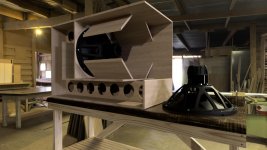
The front of the Type-R is relative small. since its modal is more depth than width. Here is a 3D image of the initial design by Ty Cention.

Great! It sometimes pay to ask since measuring correctly is a great deal harder to do, or to even be able to do, than simply just measure as I have done in the past, indoors, using an rta, at the aperture, which can be misleading when comparing results.
I normally think that as long as one describes exactly how one measures and what equipment was used as well as the state of that equipment then it is never a wasted effort, but measuring for comparative purposes requires alot more, which is what you have done, thanks, impressive!
I normally think that as long as one describes exactly how one measures and what equipment was used as well as the state of that equipment then it is never a wasted effort, but measuring for comparative purposes requires alot more, which is what you have done, thanks, impressive!
USRFobiwan,these are 2v/1m since its a 4 ohm driver. mic is calibrated using calibrator, spl meter also calibrated using calibrator. amp voltage output calibrated using TRMS meter.
The low end increase in the measurement of the Type-R-121 over the Hornresp simulation in post #27 is interesting, as is the upper extension.
1) Could you post the measurement with no smoothing?
2) What was the distance from mic and cabinet mouth to the nearest building wall (or vehicle) in your outside ground plane measurement of the Type-R-121?
3) I'm still curious (ten years after.. Tapped Horn Directivity) about the polar response of this type of sub, do you have access to an outdoor area with at 50 meter distance in all directions from boundaries you could test at 10meter/20 volt (and higher) levels?
Cheers,
Art
Last edited:
So horn response refers to these +180/180-as 90/90 and 90/630 positive ? Or 0/0 and 0/720 positive?
And if so, where's the 135 and 210 @ (+ 180?)
If you offset driver at 30
And 210(@30degrees in each pipe out of 360as 270/90)
Last edited:
Art the first image HR vs Measure is the unsmoothed response.
Distance mic <> cab. 1m.
bounderies about 30m free in front. at the sides and rear some bounderies between 10 and 15m
No i cant do 50m all arround free of bounderies. Unless I bring it to a festival gig. (which is imposible at the moment)
Here is the waterfall... also unsmoothed
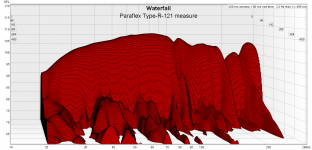
Distance mic <> cab. 1m.
bounderies about 30m free in front. at the sides and rear some bounderies between 10 and 15m
No i cant do 50m all arround free of bounderies. Unless I bring it to a festival gig. (which is imposible at the moment)
Here is the waterfall... also unsmoothed

Last edited:
Hi all! 
I posted some measurement data of the C2E-GF118 in this post recently if you are interested:
https://www.diyaudio.com/forums/sub...r-design-2.html?posted=1&posted=1#post6665269
Greetz,
Patrick
I posted some measurement data of the C2E-GF118 in this post recently if you are interested:
https://www.diyaudio.com/forums/sub...r-design-2.html?posted=1&posted=1#post6665269
Greetz,
Patrick
- Home
- Loudspeakers
- Subwoofers
- TLBP6 - Paraflex
